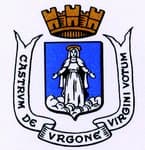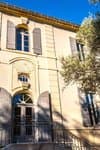
La Pierre trail
& Laquo; This walk around the town of Orgon brings a new vision of the landscapes. The observation of the pure urgonian limestone and fossils, as well as of the overview of the valley of Lavau, where a lake surrounded by steep cliffs nestles, make me travel with every visit into the mysteries of time. This geomorphological and geological diversity visible from the orientation table of the Beauregard site opens my eyes to the richness of our land. & Raquo; Fabrice Aubert, head of the Urgonia Museum.
8 points of interest

La chapelle Saint-Gervais - ©Fabrice Aubert - Musée Urgonia  Patrimony and history
Patrimony and historySaint-Gervais chapel
The Saint-Gervais chapel was built in the 15th century for the tomb of the Mouriès family, one of whose members, Elzéar, founded the hospital in 1428. Observe the built stone structure carved in urgonian limestone. Notice the deterioration effects of the stone. The high porosity weakens limestone said to be chalky and makes it particularly sensitive to the effects of time.
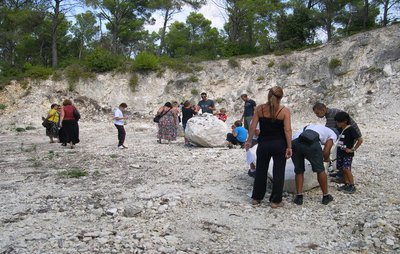
Visite de la carrière - ©Fabrice Aubert - Musée Urgonia  Geology
GeologyOld quarries
This former quarry reflects the cultivations of the 19th to the early 20th century. The limestone was, at the time, extracted into many small private quarries scattered around the town. Depending on its use, workers carved rubble stone or used explosives or mallets to fragment it. The gravel was then transported to the converted grain mills, where the wheels turned the stone to powder, used in various manufacturing processes.
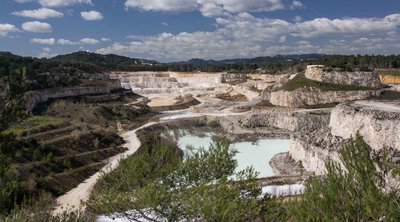
Vue sur la carrière Omya depuis le belvédère - ©Orlane Fougeroux - PNR Alpilles  Panorama
PanoramaMontplaisant viewpoint
This viewpoint overlooks the Montplaisant quarry operated since 1957. You can discover the urgonian limestone of which Orgon is the eponymous site. The economic value of this deposit is based on the purity and whiteness of the rock composed 99.98% of calcium carbonate. The areas at the end of the operation are restored with surrounding soil which naturally contains the seeds of local plant species. No reseeding is therefore necessary.

Phases calcaires - ©Fabrice Aubert - Musée Urgonia  Geology
GeologyThe limestone phases
On your left, the limestone containing flint are topped with white calcarenite (rock formed from limestone sand) upon which rests rich calcareous corals protruding the wall. These formations typical of transition areas between the deep basin and the internal Urgonian platform are discussed in detail in the geological guide written by Jean-Pierre Masse and Mukerrem Fenerci-Mass, available at the Urgonia museum.
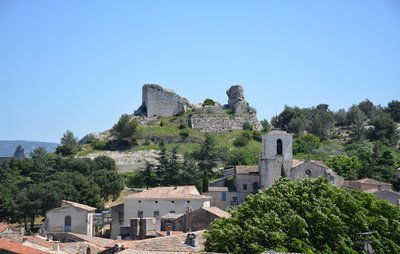
Vue sur le château - ©Fabrice Aubert - Musée Urgonia  Patrimony and history
Patrimony and historyCastle of the Duke of Guise.
This fortress, built in the Middle Ages, controlled the strategic passage between the Durance, which you can admire below, and the Alpilles. A right of passage was collected by a toll at the bottom of the cliff. It was also a prison and was destroyed by order of Richelieu in 1630.
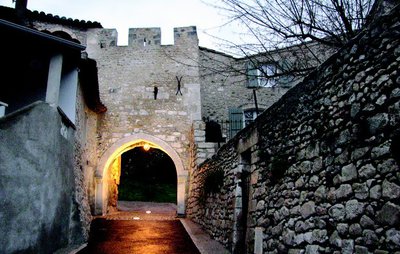
La porte de l'Hortet - ©Fabrice Aubert - Musée Urgonia  Patrimony and history
Patrimony and historyPorte de l'Hortet
This gate testifies to the first enclosure that protected the village located under the fortress. Its condition allows us to observe the guard room and an arrowslit.
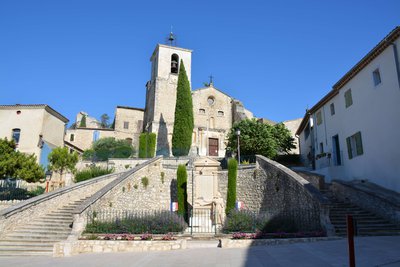
Notre-Dame-de-l'Assomption - ©Fabrice Aubert - Musée Urgonia  Patrimony and history
Patrimony and historyNotre-Dame-de-l'Assomption church
Built in 1325, this parish church has undergone many changes over time. The bell tower was built in 1660. It contains 6 bells. A U-shaped stairway built in 1669 and renovated in the 19th century provides access to the forecourts.
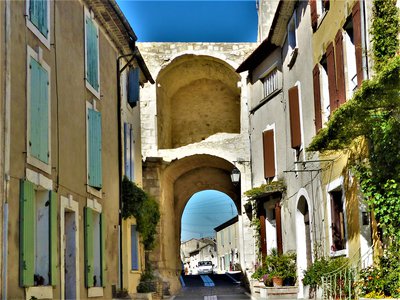
Intérieur de la porte Sainte-Anne - ©Rémi Sérange - PNR Alpilles  Patrimony and history
Patrimony and historyMedieval Gate Sainte-Anne
West entrance of the second enclosure of Orgon, it is difficult to estimate exactly its age. But we know that it has seen many important personalities since the sixteenth century. Notably, François 1st, who returned from Italy in 1516, stopped a few hours before continuing to Tarascon; Pope Pius VII, who will stay in Orgon and was lodged at the Berne Hotel No. 13 rue Edmond Coste; or Napoleon I, who passed through Orgon to go to Elba island.
Description
From the museum, climb to the arena and take the path with the windmill adjacent to the chains of the DFCI (prevention policy for forest fires) and go through the pine forest.
1 – At the direction sign, turn right towards the chapel. Let on the right and go on the left trail. Continue until about 200 m. An old quarry appair on the left.
2 – Climb the path until the viewpoint then take the trail opposite the viewpoint towards the pine forest. Go down the steps and go along a rainwater ditch bordered by drystone walls. Meet the direction sign.
3 – Turn right towards N. D. Beauregard. Climb to the cemetery going along the right side.
4 – Cross the road to the cemetery. Take the stairs and go up the little road of N.D. Beauregard. Go up to the chapel. Pass under the porch to the left and climb up to the orientation table.
5 – Go back down, pass under the porch again and take the path to the oratories on the left. Go down the steps and then turn to the right and follow the path to the reservoirs. Go down the trail towards the ruins of the castle of the Duke of Guise.
6 – Pass under the Porte de l'Hortet, a fortified gateway. Go down until the church square and take the stairs in the shape of a "horseshoe" to get to the Place de la Victoire. Continue through the Rue Jules Robert until the Porte Sainte-Anne, a fortified gateway. Pass the gateway and take the stairs on the left connected to the Urgonia Museum to end the walk.
- Departure : Urgonia Museum, Orgon
- Arrival : Urgonia Museum, Orgon
- Towns crossed : Orgon
Forecast
Altimetric profile
Recommandations
Follow the blue markings from the Urgonia Museum to the Notre-Dame de Beauregard chapel (from the starting pint to the reference point n°5), then the yellow markings of the latter until the Porte de l'Hortet.
Information desks
Bureau d'information touristique (BIT) d'Orgon
Chemin des Aires, 13660 Orgon
House of the Alpilles Regional Nature Park
2, boulevard Marceau, 13210 Saint-Rémy-de-Provence
Located in the heart of the city centre of Saint-Rémy-de-Provence, the House of the Alpilles Nature Park welcomes you to its completely renovated premises. This new vibrant place is multifunctional: it accommodates the Park's engineering team but also has a public reception space and showrooms. A true resource centre of the Park's heritage, it aims to support and promote locals, visitors and tourists on all 16 municipalities of the Park.
Open Monday to Friday, from 9 am at 12:30 pm and from 1:30 pm to 5 pm.
Free admission.
Transport
Search for the public transport timetables on the website www.lepilote.com in the municipality of Orgon.
Access and parking
On the D7N, follow the signs "Urgonia Museum".
Parking :
Source
Report a problem or an error
If you have found an error on this page or if you have noticed any problems during your hike, please report them to us here:

